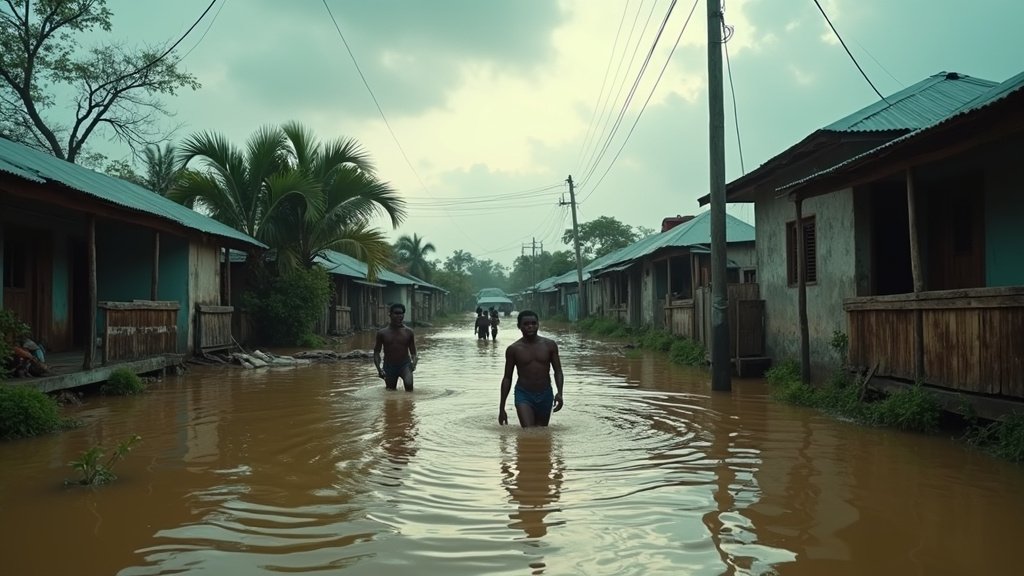Kingston, Jamaica – Jamaica is grappling with unprecedented devastation in the wake of Hurricane Melissa, a Category 5 storm that made landfall on October 28, 2025. This catastrophic event, the strongest ever recorded in modern Jamaican history, has submerged entire communities, destroyed homes, and crippled infrastructure, leaving a trail of destruction and displacement. The intensity of Hurricane Melissa Jamaica underscores the persistent vulnerability of the island nation to extreme weather events and the urgent need for enhanced disaster management strategies.
The Fury of Hurricane Melissa Jamaica
Hurricane Melissa, packing sustained winds of 185 mph, struck Jamaica with a force not seen in 174 years. The storm’s passage resulted in widespread flooding and numerous landslides, particularly affecting the southern and western parts of the island. Reports indicate catastrophic Jamaica hurricane damage to essential infrastructure, including hospitals, roads, and residential and commercial buildings. Power outages plunged 77% of the country into darkness, complicating immediate assessment and response efforts for Hurricane Melissa Jamaica. The sheer scale of destruction has led Prime Minister Andrew Holness to declare disaster areas across the island, warning of devastating impacts from Hurricane Melissa Jamaica.
Clarendon’s Vulnerability Exposed by Floodwaters During Hurricane Melissa Jamaica
The parish of Clarendon, known for its low-lying and flood-prone areas, has been particularly hard-hit by the relentless rainfall from Hurricane Melissa. While specific reports on Bottom Halse Hall were not detailed in the immediate aftermath news, the broader impact on Clarendon highlights the severe risk faced by such communities during the Hurricane Melissa Jamaica event. Heavy rainfall overwhelmed existing drainage systems, inundating residential areas and forcing widespread evacuations. Residents like Denise Sinclair, described in initial reports, faced harrowing escapes as floodwaters rose rapidly, underscoring the immediate danger to life and property in these vulnerable regions. The Office of Disaster Preparedness and Emergency Management (ODPEM) had issued evacuation orders for several high-risk areas within Clarendon, including Portland Cottage and Rocky Point, as the storm approached, urging residents to move to safer ground to escape the Hurricane Melissa Jamaica impact.
Official Response and Community Resilience to Hurricane Melissa Jamaica
In response to the crisis, the Jamaican government, led by Prime Minister Holness and with the coordination of Minister of Local Government Desmond McKenzie, activated nationwide emergency mechanisms. The ODPEM has been central to coordinating relief operations, working alongside agencies like the Jamaica Red Cross, which deployed teams to assist with emergency responses and shelter management. Evacuation orders were enforced, with support from the Jamaica Urban Transport Company (JUTC) and the Jamaica Constabulary Force to aid in the relocation of residents from threatened areas during the Hurricane Melissa Jamaica crisis.
Despite the overwhelming destruction from Hurricane Melissa Jamaica, stories of resilience and community solidarity are emerging from across the island. Neighbors have been seen helping each other, and local volunteers have stepped forward to assist in recovery efforts. This spirit of cooperation is a testament to the strength of the Jamaican community in the face of adversity, even after the Hurricane Melissa Jamaica impact.
Persistent Challenges and the Path Forward for Hurricane Melissa Jamaica
The devastating Hurricane Melissa Jamaica impact has once again brought to the forefront the recurring issue of flooding and infrastructure vulnerability in Jamaica. For years, experts have noted that the island’s civil works infrastructure has struggled to keep pace with development, leading to increased flood risks, even outside of major hurricane events. The National Works Agency (NWA) and local municipal corporations face the ongoing challenge of maintaining and upgrading drainage systems, which are often overwhelmed by significant rainfall, a clear indicator of Infrastructure vulnerability exacerbated by Hurricane Melissa Jamaica.
The debate over the long-term suitability of certain areas for habitation, as mentioned in the initial context, is amplified by such events. Addressing these deep-seated issues requires a comprehensive approach, including significant investment in climate-resilient infrastructure, robust disaster preparedness plans, and effective land-use management policies. The government’s commitment to recovery efforts, including the launch of a dedicated recovery website, signals an intent to rebuild and strengthen the nation’s defenses against future climate-related threats, particularly in light of Hurricane Melissa Jamaica.
Conclusion: Lessons from Hurricane Melissa Jamaica
Hurricane Melissa has inflicted immense suffering and loss upon Jamaica, testing the resilience of its people and the robustness of its infrastructure. As the nation begins the arduous task of recovery and rebuilding from the Hurricane Melissa Jamaica disaster, the focus must remain on creating more sustainable and resilient communities. The news from Clarendon and other affected areas serves as a stark reminder of the critical need for proactive measures and long-term solutions to protect Jamaica’s communities from the escalating threats of climate change and extreme weather, a lesson learned starkly from Hurricane Melissa Jamaica.

